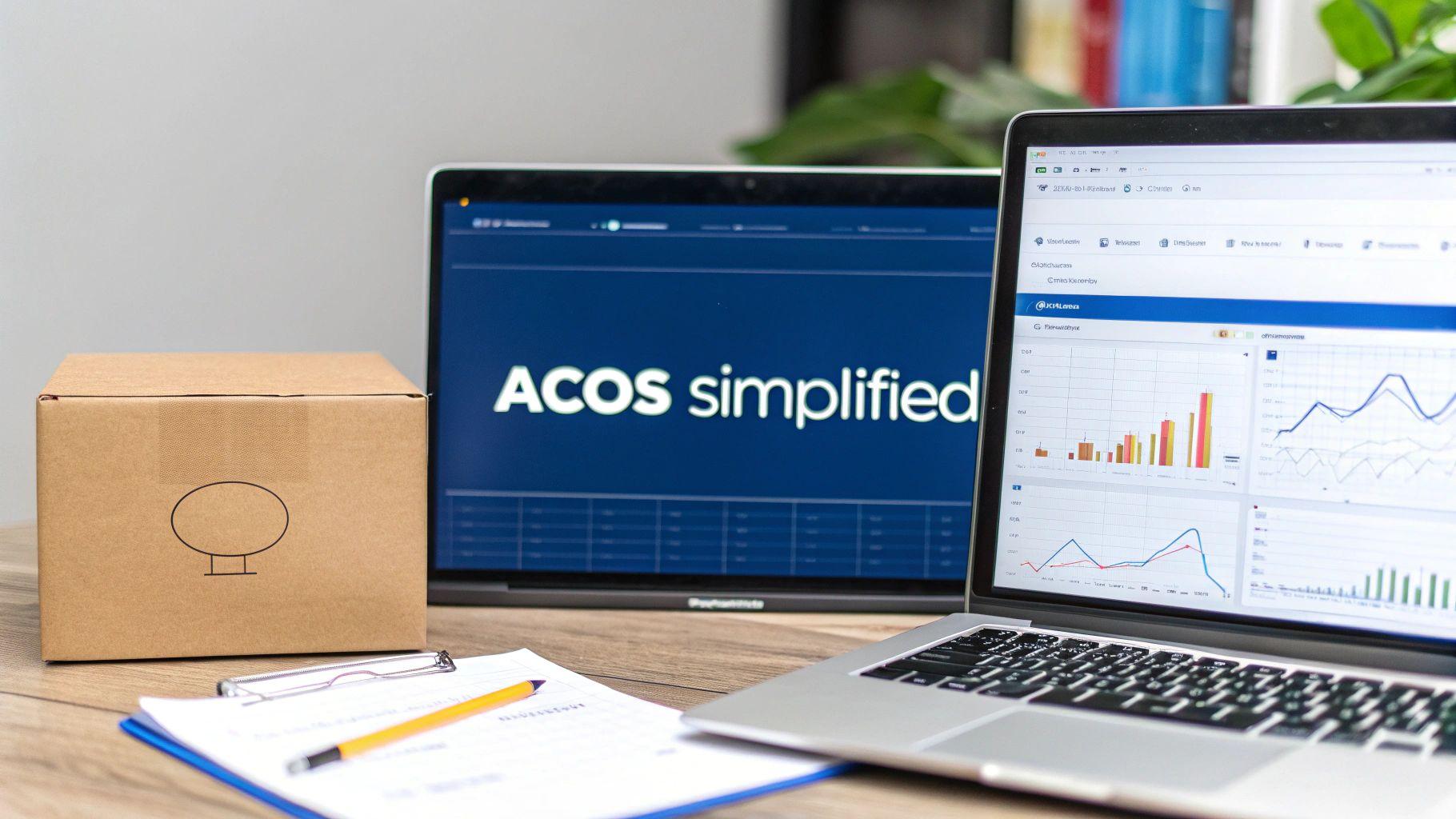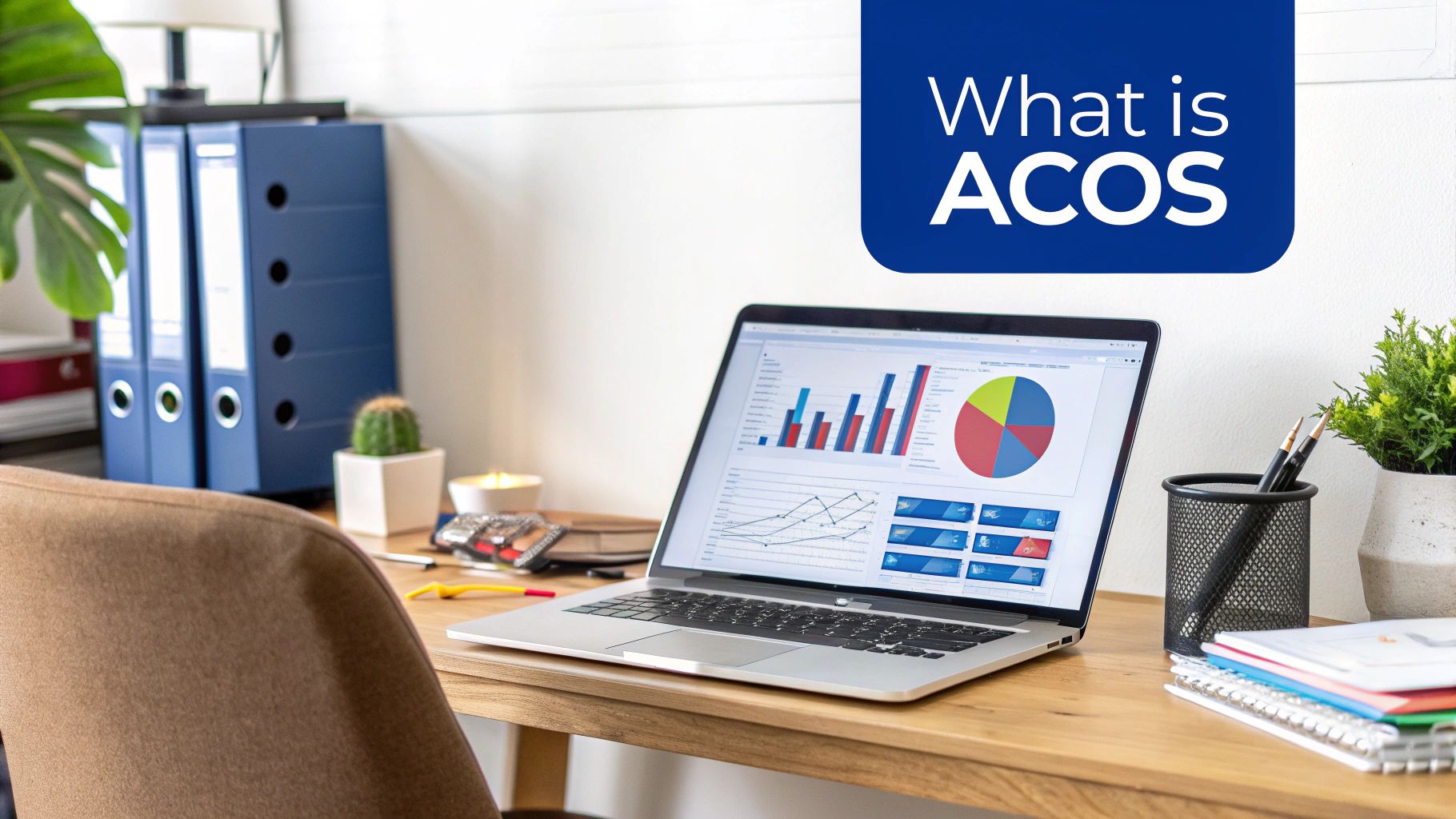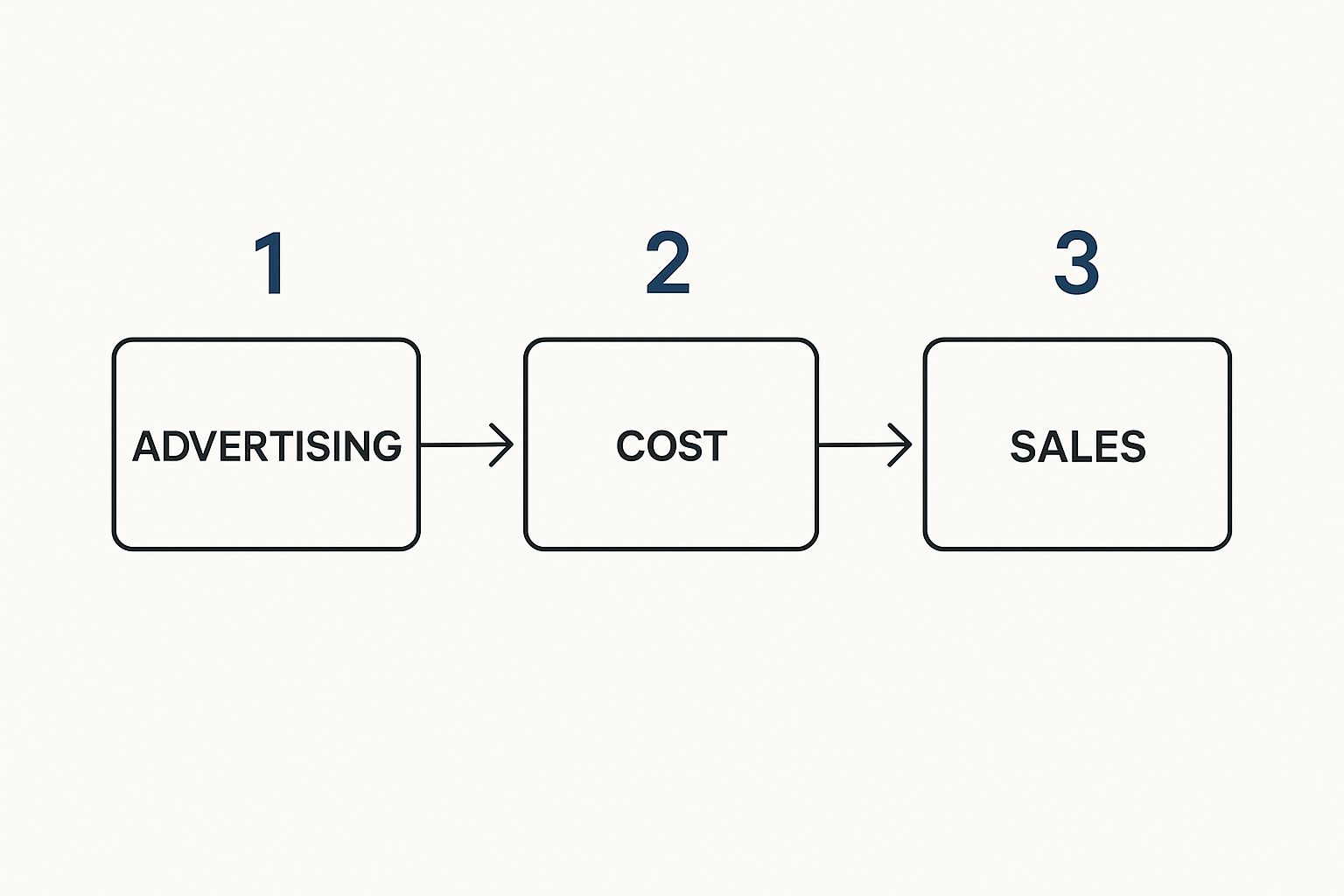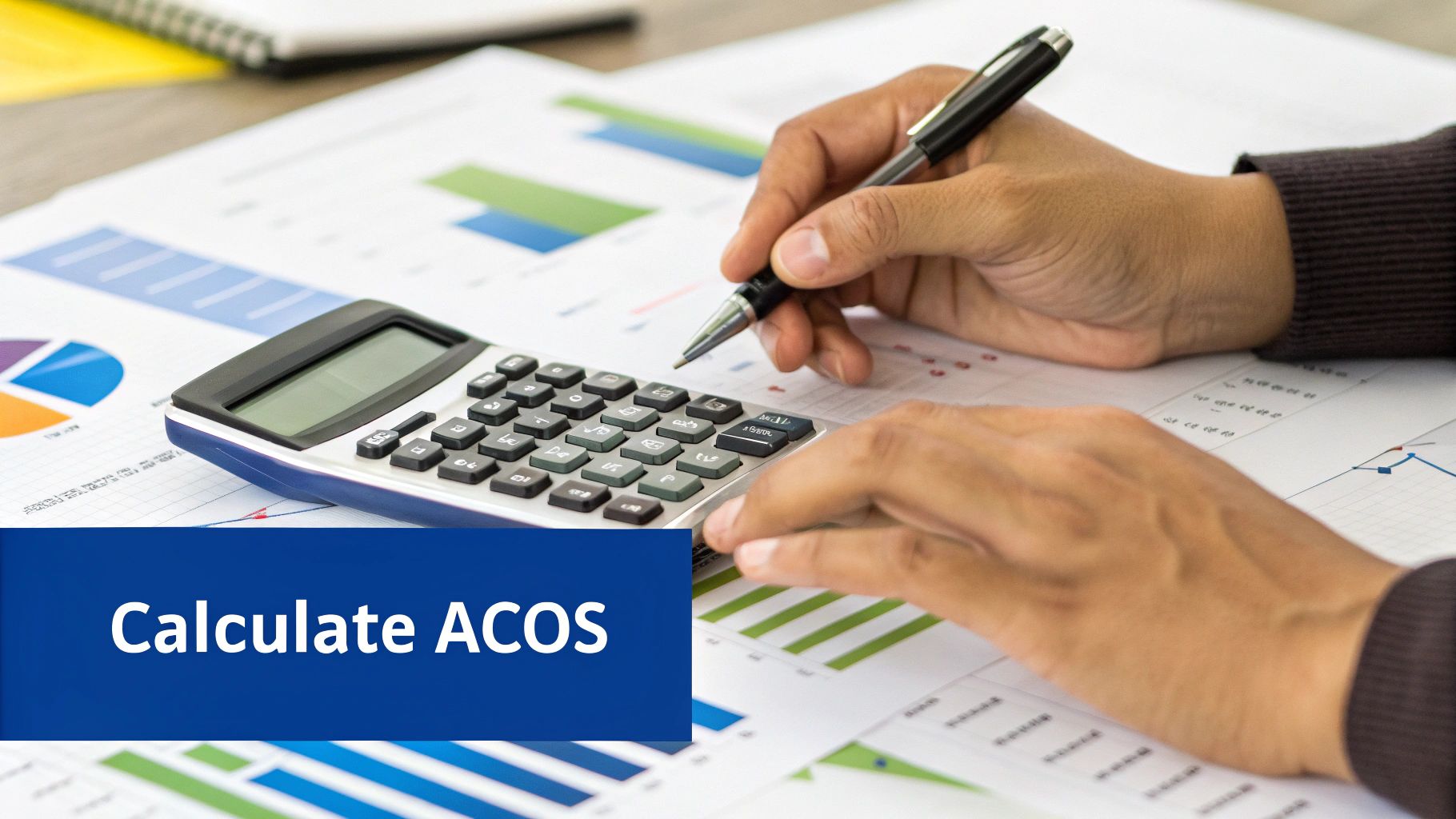What Does ACoS Stand For? An Amazon Performance Marketing Guide
What does ACoS stand for? Learn how this key metric drives Amazon PPC strategy, protects profitability, and boosts your organic growth.

So, what exactly is ACoS? Let's cut through the noise.
ACoS stands for Advertising Cost of Sales. It's the most direct metric for measuring the efficiency and immediate profitability of your Amazon PPC campaigns. In simple terms, it's the percentage of sales revenue you spent on advertising to achieve those sales.
For eCommerce leaders, ACoS isn't just another KPI—it's a critical lever for campaign optimization.
How Is ACoS Calculated?

For any brand serious about scaling on Amazon, mastering ACoS is non-negotiable. It transforms ad spend from a simple line-item expense into a measurable growth driver. Without a firm grasp on this metric, you're essentially spending blind.
The calculation is straightforward: divide total ad spend by total ad revenue, then multiply by 100 to express it as a percentage.
Here's a quick breakdown of the formula and its components.
| The ACoS Formula Explained | ||
|---|---|---|
| Component | Definition | Example |
| Ad Spend | The total cost of your Amazon PPC ads over a defined period. | You invested $500 in ads this week. |
| Ad Revenue | The total sales generated directly from clicks on those ads within the same period. | Those ads generated $2,000 in sales. |
| ACoS Formula | (Ad Spend / Ad Revenue) x 100 | ($500 / $2,000) x 100 = 25% |
This simple calculation provides a powerful, top-level snapshot of campaign performance, telling you precisely how efficiently your ad dollars are converting into sales.
ACoS in a Real-World Scenario
Let's apply this to a practical example. Imagine your brand sells high-end coffee makers and you’re running a Sponsored Products campaign.
- You invest $500 in the campaign over one week.
- During that week, clicks from those specific ads generate $2,000 in sales.
Using the formula:
($500 Ad Spend ÷ $2,000 Ad Revenue) x 100 = 25% ACoS
This 25% means for every dollar in revenue generated by an ad, you spent 25 cents on advertising. But is 25% a good ACoS? That's the critical question for any brand leader. The answer is nuanced and depends entirely on your product's profit margin and your strategic objective for that specific campaign—a topic we'll explore next.
ACoS is more than a metric; it's the language of Amazon advertising performance. Mastering it is the first step toward making intelligent, data-driven decisions that fuel sustainable growth.
For those looking to situate Amazon ads within a broader framework, this beginners guide to digital marketing offers foundational context. Understanding the fundamentals helps contextualize how metrics like ACoS directly link ad spend to business outcomes.
Finding Your Break-Even ACoS To Protect Profit Margins
Knowing your ACoS is elementary. Understanding what it should be is where strategy begins. This brings us to your Break-Even ACoS—the absolute ceiling for your ad spend on a given product. Exceed this percentage, and you are officially losing money on every ad-driven sale.
It’s the precise tipping point where advertising costs consume your entire pre-ad profit margin. Calculating this figure transforms ACoS from a reactive metric into a powerful guardrail for profitability. It’s how you ensure campaigns contribute to the bottom line, rather than eroding it.
Calculating Your Profitability Guardrail
To determine your break-even point, you must first calculate your product's profit margin before factoring in ad spend. This is the revenue remaining after all costs associated with selling the product are accounted for.
This process illuminates how ad spend directly impacts your sales revenue and, ultimately, your P&L.

The data flow is clear: every advertising dollar must be justified by the revenue it generates, or the unit becomes unprofitable.
Here are the inputs required for the calculation:
- Retail Price: The final price paid by the customer.
- Cost of Goods Sold (COGS): Includes manufacturing, inbound shipping, and packaging costs.
- Amazon Fees: Critically, this includes the referral fee (typically 15%) and FBA fulfillment fees.
Let’s model this with a real-world example. A product sells for $50. Your COGS are $15, and total Amazon fees amount to $10.
Your pre-ad profit is:
$50 (Retail Price) - $15 (COGS) - $10 (Amazon Fees) = $25 Profit
To derive your Break-Even ACoS, divide this pre-ad profit by the retail price:
($25 Profit / $50 Retail Price) x 100 = 50% Break-Even ACoS
This 50% is your strategic threshold. An ACoS above this number means you are paying more to acquire a customer than the profit that customer generates. It is an unsustainable model for mature products.
While vital, ACoS is just one performance metric. To see how it compares to a related, but distinct, metric used in broader digital advertising, explore our guide on what is cost per acquisition.
Setting Your Target ACoS Based on Business Goals

A common question from brand leaders is, “What’s a good ACoS?” The only correct answer is: it depends entirely on your strategic objective. There is no universal benchmark. A "good" ACoS is one that is purpose-driven and aligned with a specific business goal.
Blindly chasing a low ACoS can suffocate a new product's growth potential. Conversely, allowing ACoS to run unchecked without a clear strategy can incinerate profits.
Your target ACoS is not a static figure. It must be a dynamic metric that adapts to your product’s lifecycle stage and your current business objective. Launching a new ASIN is a fundamentally different challenge than managing a category-leading bestseller, and your advertising strategy must reflect this reality.
Matching ACoS Targets to Your Game Plan
The key is to shift from reacting to ACoS to proactively setting it as a strategic tool. Is the primary goal aggressive market share acquisition or profit maximization for an established hero product? The answer dictates your target ACoS.
Consider these two divergent scenarios:
Launch & Growth Phase: When launching a new product, immediate profitability is secondary to gaining market traction. The objectives are visibility, sales velocity, and data acquisition. Here, a high ACoS is a calculated investment. For a product with a 30% break-even margin, a launch ACoS of 50-60% might be a sound strategy. This "loss leader" approach is designed to rapidly climb organic rankings and discover high-converting keywords, paving the way for future organic sales. For example, a CPG brand entering a competitive snack category might budget for an 80% ACoS for the first 90 days to secure top-of-search placement and drive initial trial.
Profitability & Maturity Phase: For an established product with strong organic rank, the objective shifts to maximizing cash flow and profitability. In this phase, you need a low ACoS—well below your break-even point. For the same product with a 30% break-even, the target might be adjusted down to 15-20%. This ensures every ad dollar delivers a significant and immediate return, funding other growth initiatives.
View your ACoS target as a declaration of strategic intent. A high ACoS signals an investment in future organic growth. A low ACoS prioritizes immediate profitability.
Understanding what ACoS stands for is the first step. The real expertise lies in defining what it should stand for within the context of your specific business objectives.
Using ACoS to Fuel Your Organic Growth Flywheel
Here’s the mindset shift that separates market leaders from the rest: they don’t view Advertising Cost of Sales as a mere expense. They treat it as a strategic investment in their long-term organic ranking. Many brands operate in silos, treating PPC and organic performance as disconnected channels. This is a critical error.
On Amazon, strategic advertising ignites a powerful virtuous cycle known as the "flywheel effect." A well-executed PPC campaign drives initial sales. This sales velocity signals to Amazon's A10 algorithm that your product is relevant and desirable. In response, Amazon rewards your product with a higher organic search position for your most valuable keywords.
This means a temporarily high ACoS, when deployed with purpose, becomes a powerful growth lever. You're not just buying clicks; you are acquiring customers, generating sales history, and capturing valuable keyword real estate, all of which directly fuel your organic visibility. You are, in effect, capitalizing the launch of a cycle that eventually becomes self-sustaining through organic sales.
From Expense to Capital Investment
This reframing transforms your entire perspective on the advertising budget. It's no longer just an operating expense for driving today's sales; it's a capital investment in a durable brand asset on the Amazon platform. You are purchasing data, sales history, and market share—assets that appreciate over time.
By strategically "overspending" on ACoS during a product launch or a key promotional period, you are funding the flywheel. The objective is to reach a tipping point where organic sales momentum surpasses paid sales, driving down your total advertising cost as a percentage of total sales.
A successful Amazon PPC marketing strategy is one that holistically considers the interplay between paid and organic channels. While ACoS is your tactical tool for campaign management, a comprehensive growth plan requires strong content. To broaden your perspective, this guide on mastering digital marketing content strategy can help round out your approach.
Measuring Your True Growth With Total ACoS (TACoS)

While ACoS is an essential metric for campaign-level optimization, it provides an incomplete picture. It measures ad efficiency in isolation but fails to reveal advertising's impact on your overall business health.
For that, you must analyze Total Advertising Cost of Sales (TACoS). This is the metric that connects advertising performance to total business growth.
TACoS provides a 30,000-foot view of your brand’s performance on Amazon. Instead of comparing ad spend solely to ad-driven revenue, TACoS compares total ad spend to your total revenue—both paid and organic. It reveals the true relationship between your advertising investment and your brand’s overall sales trajectory.
The formula is:
TACoS = (Total Ad Spend ÷ Total Revenue) x 100
Why TACoS Is Your True North Metric
The power of TACoS lies not in a single data point, but in its trend over time.
A decreasing TACoS is one of the most positive indicators for an Amazon brand. It is concrete evidence that your ad spend is generating a powerful "halo effect"—lifting organic sales, improving keyword rankings, and building a more sustainable and less ad-dependent business. Your advertising is no longer just buying sales; it's building an asset.
This metric provides the strategic justification for your advertising budget, measuring the true, long-term ROI. For a deeper dive, our complete guide explains how to calculate TACoS and integrate it into your strategy.
If your ACoS remains stable while your TACoS trends downward, you've unlocked the ultimate goal on Amazon: your advertising is efficiently fueling a disproportionate increase in organic sales, boosting overall profitability.
Think of ACoS as your tactical, micro-level metric and TACoS as your strategic, macro-level one. This table clarifies their distinct roles.
ACoS vs. TACoS: A Strategic Comparison
| Metric | What It Measures | Best Used For |
|---|---|---|
| ACoS | The efficiency of specific ad campaigns (ad spend vs. ad revenue). | Tactical, day-to-day campaign optimization and profitability analysis at the product or campaign level. |
| TACoS | The overall health and leverage of your marketing program (total ad spend vs. total revenue). | Strategic, long-term assessment of how advertising drives organic growth and impacts overall business profitability. |
Ultimately, tracking TACoS is what separates managing campaigns from building a dominant brand on the marketplace. It ensures your ad dollars are fueling sustainable, long-term enterprise value.
Don't Fall for These Common ACoS Traps
Data is only powerful when interpreted correctly. I've seen numerous brands fall into common traps when analyzing their Advertising Cost of Sales, leading to poor decisions that stifle growth or burn capital.
The most prevalent mistake is celebrating an exceptionally low ACoS as an unqualified victory. While efficient on the surface, an ACoS that is too low is often a red flag for overly conservative bidding. It indicates you are likely leaving profitable sales on the table and conceding market share to more aggressive competitors.
Conversely, panicking over a high ACoS during a product launch is equally detrimental. A high ACoS in this phase is not a failure; it is a calculated investment in visibility, data acquisition, and kickstarting the organic ranking flywheel. A case study with a client in the competitive supplement space showed that by intentionally running a 110% ACoS for 60 days post-launch, they secured a "Best Seller" badge in month three, which then allowed them to scale back ad spend and profit from the sustained high organic rank.
Context is Everything
It’s also crucial to be precise with terminology. Outside the Amazon ecosystem, "ACOS" has entirely different meanings. In the US healthcare industry, for example, it refers to an Accountable Care Organization.
An Accountable Care Organization (ACO) is a group of healthcare providers who collaborate to deliver coordinated high-quality care to their Medicare patients. You can find the official definition on their website.
This highlights the critical importance of context. Your ACoS is a dynamic figure. Its performance—"good" or "bad"—is wholly dependent on your strategic objective, product lifecycle stage, and underlying profit margins.
The key takeaway is to stop evaluating ACoS in a vacuum and start analyzing it within the broader context of your overarching business strategy.
Got Questions About Amazon ACoS? We've Got Answers.
Here are concise, no-nonsense answers to the most frequent questions we receive from retail and eCommerce leaders.
Should My ACoS Always Be Lower Than My Profit Margin?
For a mature, established product where the goal is profitability, yes—your ACoS must be below your break-even ACoS.
However, for a new product launch, this rule does not apply. It is standard practice to set a target ACoS that is 1.5x to 2x your profit margin for the initial launch phase (e.g., the first 30-90 days). This is an investment in market penetration and building sales velocity to trigger Amazon's algorithm.
How Often Should I Be Checking My ACoS?
Monitor ACoS every few days to understand trends, but avoid making reactive, daily adjustments.
Amazon's sales attribution can have a lag of up to 72 hours. A more effective cadence is a thorough weekly performance review. This provides a sufficient data set to make informed, strategic decisions regarding bids, budgets, and targeting without overreacting to daily fluctuations.
Does ACoS Account For All My Amazon Fees?
No, and this is a critical point of failure for many brands. ACoS is a simple ratio of ad spend to ad revenue.
It does not account for your Cost of Goods Sold (COGS), Amazon's referral fees, or FBA fulfillment fees. This is precisely why calculating your true, all-in Break-Even ACoS for each product is a non-negotiable first step. Without this profitability guardrail, you are making decisions in the dark.
At Headline Marketing Agency, we move beyond surface-level metrics like ACoS. We architect performance advertising strategies that drive profitable market share gains and sustainable organic growth. Discover how our expert team can help you dominate your category on Amazon.
Ready to Transform Your Amazon PPC Performance?
Get a comprehensive audit of your Amazon PPC campaigns and discover untapped growth opportunities.